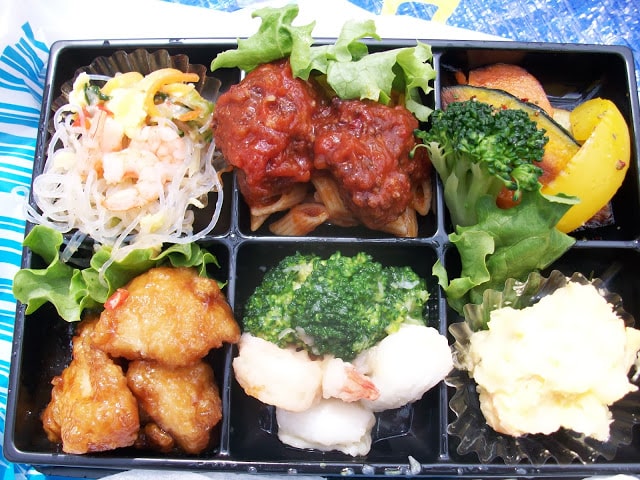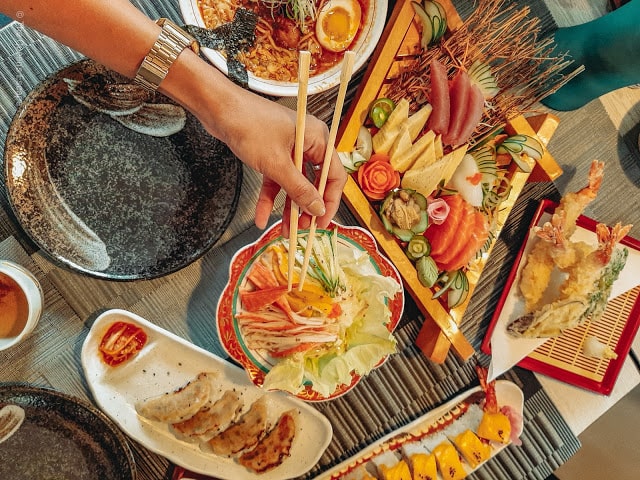All I knew was sushi and under it I grouped everything with rice and raw fish. But obviously Japanese gastronomy is much more than sushi and as I got to know different Japanese restaurants I realized how much I didn’t know about it.
That’s why I thought of making this mini dictionary of basic terms of Japanese gastronomy, for those of you who still think sashimi sounds like a kind of cat food. I’m sure some of you already know them, but there’s always something new to discover!
Dorayaki
Do you remember the round dumplings that Doraemon used to eat? Well, those are the dorayaki, sponge cakes filled with azuki, a red bean paste widely used in Japanese pastries.
Futomaki
It is a subcategory within the makis. In this case, futomaki are larger and wider than makis and have a wide variety of ingredients inside.
Gari
It is very common that when we order sushi we find in a corner of the plate some very thin slices of something pink. It is the gari, pickled ginger with a curious sweet taste with a spicy and fresh touch. It should be eaten between each piece of sushi because its purpose is to “clean” the mouth to capture all the flavor of the next bite of sushi.
Gohan
It is the common boiled rice. It can be compared to what bread is for us, since in Japan it is a very common accompaniment to all meals.

Gyoza
Japanese dumpling stuffed with meat and/or vegetables, fried or grilled. It is usually served with a sauce seasoned with rice vinegar. There are Chinese and Korean versions of this popular Asian dish.
Kakigori
Japanese ice cream made from shaved ice that is dressed with flavored syrup. It is also known as snow ice cream. The flavors are very varied: green tea, melon, grape, strawberry, lemon… It can also be sweetened with condensed milk.
Kastera
A very popular sponge cake in Japan that curiously has Spanish origins! This cake was born in 1480 in Castile and was known as “Ca stilla”. Years later it was exported to Portugal, where a group of missionaries took it to the city of Nagasaki along with other products such as wine.
From that moment on, the cake spread throughout the country and due to the phonetic characteristics of Japanese, its name was changed to “Kast era”. It is made with flour, sugar, egg and starch syrup, and it is very common to see it at festivals and street food stalls.
Katsudon
It is a very hearty dish consisting of a bowl of rice topped with a battered pork chop, mixed with scrambled egg and other ingredients. I recently read that in Japan students usually eat katsudon the night before an important exam, and it is because the word “katsu” sounds the same as the verb “to win” or “to be victorious”. But whether you have an exam or not you must go and try the katsudon at Nagase Japanese restaurant, really delicious.
Maki
Means “rolled” and is a type of sushi made of rice surrounded by nori seaweed inside which are placed two or three ingredients, such as fish or vegetables and a little wasabi.
Matcha
It is a type of green tea used in the Japanese tea ceremony. But besides as an infusion, it is also used in the preparation of desserts, such as mochi filled with green tea or “castella”, a very popular green tea cake.
Mochi
Perhaps the best known Japanese dessert. Its soft and fluffy texture is totally different from the “usual” food. The reason? It is made with a variety of glutinous rice that gives it those sticky but palatable qualities. This dumpling-shaped cake can be filled with strawberry, chocolate, red bean or green tea, which is the most popular. In the Japanese pastry shop Takashi Ochai in Barcelona they make finger-licking mochis.
Nigiri
It is a type of sushi formed by an elongated rice ball and a piece of fish or other ingredient on top. Sometimes a nori seaweed is placed around it as a girdle so that the ingredient does not move.
Okonomikayi
It is also known as Japanese pizza, due to the variety of ingredients it contains, although its taste is nothing like the usual pizza. Okonomiyaki has a base of flour, water and egg that can be mixed with vegetables, meat or fish, soba noodles, shrimp, bacon, etc. Or all at once! There are endless varieties of okonomiyaki in every region of Japan.
Ponzu
It is one of the most used sauces in Japanese food. It is a kind of vinaigrette made with rice vinegar and yuzu (Japanese citrus fruit) used to dress tuna tataki or salads, for example.

